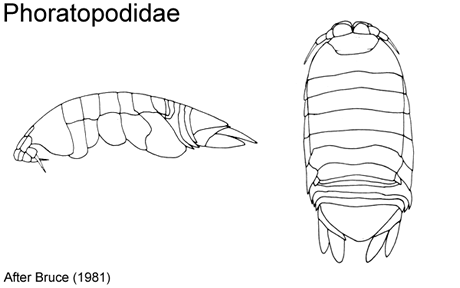 |
||||||
|
|
|
|
|
|
Australian Isopoda: FamiliesS.J. Keable, G.C.B. Poore & G.D.F. WilsonPhoratopodidae Hale, 1925 Phoratopodidae Hale, 1925: 158. -Bruce, 1981: 107. -Roman & Dalens, 1999: 232. Description. Body. Body shape without loss or gross modification of appendages on one side of the body; in dorsal view without peduncular articles of antenna 1 or 2 contiguous with coxal margins. Head. Head not capable of lateral rotation (laterally encompassed, abutting or fused to pereonite 1). Eyes widely separated and small, or absent. Antenna 1 inserting on head anteriorly and/or dorsally to antenna 2, minute or well developed; not as follows: reduced to 2 articles with second article expanded and scalloped. Antenna 2 well developed. Mouthparts not forming suctorial cone or proboscis. Mandible not projecting anteriorly and together forceps-like; incisor subequal to or broader than narrowest width of mandible body, not produced distally into piercing structure; spine row not forming obvious circular raised cusp with spines on margin, may be vestigial or absent; molar not forming prominent triangular process projecting beyond body of mandible with spines along distal margin, may be vestigial or absent; palp present. Maxillule lateral lobe apex without hooked robust setae. Maxilliped palp medial margin recurved spine-like robust setae absent; endite conspicuous. Pereon. Pereonites 6-7 pereonite 7 distinct dorsally, free. Coxae extending ventrally and laterally to overhang the coxa-basis articulation of the pereopods. Coxa 1 and pereonite 1 fused. Pereopods 6-7 pairs readily apparent; 1-3 or 1-7 not prehensile. Pereopods 5-7 with flattened setose articles and dactyls modified or absent. Pleon / Pleotelson. Pleonites and pleotelson not arranged as follows: pleonites 1-5 fused but with conspicuous lateral sutures, pleotelson fused to pleonites 1-5; pleonites 1-5 fused but with conspicuous lateral sutures, pleotelson not fused to pleonites 1-5; pleonites 1-5 fused without conspicuous sutures, pleotelson not fused to pleonites 1-5; pleonites 2-5 fused but with partial (usually lateral) sutures, pleotelson wholly or partly fused with pleonites 2-5; pleonites 3-5 fused without lateral sutures, pleotelson fused with pleonites 3-5, pleonites 1 and 2 free but may be only small rings or cuticular bars visible ventrally. Pleonite 5 subequal to or shorter than any of pleonites 1-4. Pleopods 5 pairs present. Pleopod 2 of males not consisting of an enlarged peduncle with a geniculate endopod and a small muscular exopod. Uropods positioned proximally on pleotelson; distinct from pleopods, not forming operculum over pleopodal chamber (although may be folded ventrally below pleotelson). Peduncle not forming an elongate clavate article with rami reduced or absent; not fused to endopod. Rami inserting on peduncle adjacent to each other. Endopod present, not claw-like (acute and recurved) andor posteroventral in position. Exopod not folded dorsally over pleotelson. Distribution and generic composition. Monotypic. Phoratopus remex Hale, 1925 is known from off Encounter Bay and Fowlers Bay, South Australia, Australia, in depths to 78m (Bruce, 1981).
Cite this publication as: 'S.J. Keable, G.C.B. Poore & G.D.F. Wilson (2002 onwards). 'Australian Isopoda: Families. Version: 2 October 2002. https://crustacea.net'. |
|
|
|
|
|
|
|
|
|
Copyright © Australian Museum, 2002 - 2003
Australian Museum website
